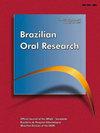Effect of CO2 laser combined with AmF/NaF/SnCl2 solution on the prevention of human and bovine enamel erosion.
IF 2.5
4区 医学
Q2 Dentistry
引用次数: 0
Abstract
This in vitro study evaluated the potential of CO2 laser (10.6 μm) combined with a stannous/fluoride-containing solution for preventing erosion in human/bovine enamel. Forty-eight samples of each substrate were randomly allocated to four groups (n = 12): W - distilled water; E - AmF/NaF/SnCl2 solution; L - CO2 laser; and LE - CO2 laser+AmF/NaF/SnCl2 solution. After surface treatments, samples were submitted to a 5-day erosive challenge, alternating immersions in 0.5% citric acid (2 minutes, 6x/day) and in artificial saliva. Optical profilometry (μm) and scanning electron microscopy (SEM) were used to determine surface loss and surface morphology, respectively. Data were statistically analyzed by two-way ANOVA and Tukey's tests (p < 0.05). For human enamel, tissue loss was lower in group L (12.37 ± 4.46) than in group W (16.45 ± 2.76), and higher than in the groups treated with AmF/NaF/SnCl2 solution (E-5.44 ± 2.37; LE-5.55 ± 2.31). In group L, SEM images reveled a disorganized surface but fewer projections than in group W and LE showed fewer irregularities than W, E, and L. For bovine enamel, tissue loss in group L (13.90 ± 3.50) did not differ from that in group W (14.10 ± 2.98), and was higher than losses in groups E (5.70 ± 2.12) and LE (8.12 ± 2.56), which were statistically similar to each other. Groups W and L had similar aspects of demineralization, whereas groups E and LE showed homogenous surfaces. Surface-treated samples had no changes in their surfaces. CO2 laser was able to slightly prevent surface loss only on human enamel surface, but did not enhance the AmF/NaF/SnCl2 effect on the prevention of enamel erosion.CO2激光联合AmF/NaF/SnCl2溶液对人和牛牙釉质侵蚀的预防作用。
本实验评估了CO2激光(10.6 μm)与含锡/氟化物溶液联合用于预防人/牛牙釉质侵蚀的潜力。每种基质样品48份,随机分为4组(n = 12): W -蒸馏水;E - AmF/NaF/SnCl2溶液;L - CO2激光器;LE - CO2激光+AmF/NaF/SnCl2溶液。表面处理后,样品进行为期5天的侵蚀挑战,交替浸泡在0.5%柠檬酸中(2分钟,6次/天)和人工唾液中。采用光学轮廓术(μm)和扫描电镜(SEM)分别测定了表面损耗和表面形貌。数据采用双因素方差分析和Tukey检验(p < 0.05)进行统计学分析。人牙釉质组织损失,L组(12.37±4.46)低于W组(16.45±2.76),高于AmF/NaF/SnCl2溶液组(E-5.44±2.37;le5.55±2.31)。L组牛牙釉质的扫描电镜(SEM)显示表面无组织,但突起量少于W组,LE组的不规则性少于W组、E组和L组。L组的组织损失(13.90±3.50)与W组(14.10±2.98)无显著差异,高于E组(5.70±2.12)和LE组(8.12±2.56),两者差异有统计学意义。W组和L组脱矿面相似,E组和LE组脱矿面均匀。经过表面处理的样品表面没有变化。CO2激光仅对人牙釉质表面有轻微的保护作用,而AmF/NaF/SnCl2对牙釉质侵蚀的保护作用没有增强。
本文章由计算机程序翻译,如有差异,请以英文原文为准。
求助全文
约1分钟内获得全文
求助全文
来源期刊

Brazilian Oral Research
DENTISTRY, ORAL SURGERY & MEDICINE-
CiteScore
3.70
自引率
4.00%
发文量
107
审稿时长
12 weeks
 求助内容:
求助内容: 应助结果提醒方式:
应助结果提醒方式:


